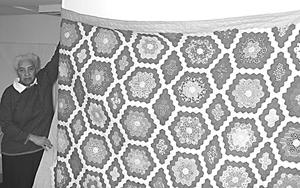AROUND THE FRAME
 Catherine’s flower garden quilt.
Catherine’s flower garden quilt.
One of the most popular quilt designs of the 1925 -1940 era was Grandmother’s Flower Garden. Comprised of hexagons and generally featuring a plain color hexagon “path” to set one garden off from another, these quilts reveal the creativity of their maker.
Many flower garden quilts were assembled using the English paper-piece method, while other quilt makers opted to simply sew one hexagon to another. Flower garden quilts are an ideal way to utilize scraps; giving each garden a unique look. Some flower garden quilts are made entirely of plain fabric giving it a more structured look.
Several years ago I met Catherine Burch through a local quilt shop. She had purchased a vintage flower garden quilt top at a Goodwill store in Ohio back in the 1970s. She asked me to finish it assuring me she is in “no hurry” to have it hand-quilted. The top had sustained some damage; one “garden” a near total loss including the dark green hexagons that set off the blocks. In order to keep the color constant, green hexagons from around the outer edge are stolen and moved. White hexagons replace the green hexagons a barely noticeable difference. The damaged block is restored using vintage floral prints.
Before I agree to the daunting task of finishing the top, Catherine needs to agree to one request. Binding the quilt is going to be difficult. It will require using bias-cut fabric and having to miter corners every two inches. Maneuvering it under a presser foot stopping and starting every two inches is not a task I want to undertake.
The funny thing is, I’m apparently not the only one who feels that way. I’ve come across quilt tops where the maker simply either cut off or hemmed under the edge pieces to form straight lines. Being an advocate of “first do no harm”, I propose to Catherine she purchase reproduction fabric of the era and have me appliqué it underneath the top in order to fill in and create a straight edge border. She agrees. After the appended top is sandwiched to batting and back fabric, the hand quilting begins.
It is nearly three years later before the estimated 5,046 hexagons and border are quilted. In the meantime, Catherine joins Sisters of the Cloth a local quilt guild and starts to quilt. It was a joyful day when Catherine and her quilt were united. The quilt was displayed at the 2009 Gathering of Quilters held at the Fort Wayne Allen County War Memorial Coliseum where its size, pattern and technique drew many enthusiastic comments.
Now displayed in her guest bedroom, Catherine truly appreciates the effort and love that went into the completion of her quilt top and I have an inkling why the original maker never finished it!
- Sewing For A Higher Purpose ~ Around The Frame - April 12, 2024
- National Quilting Day 2024 ~ Around The Frame - March 1, 2024
- Reunited! ~ Around The Frame - February 2, 2024


